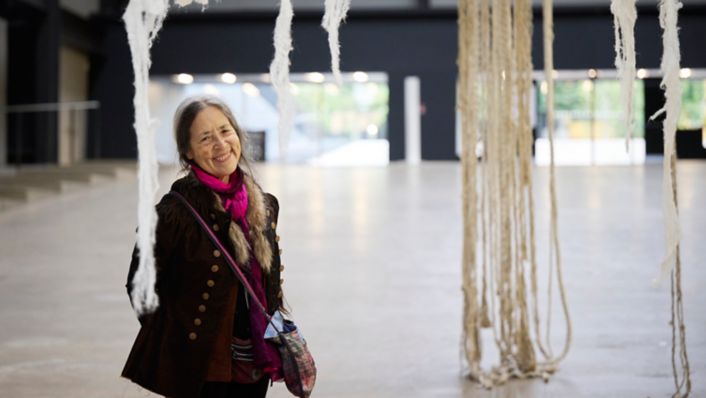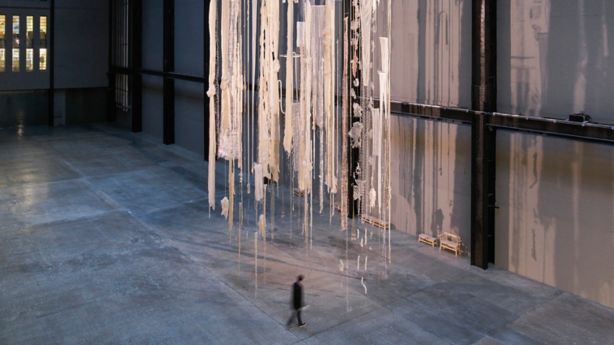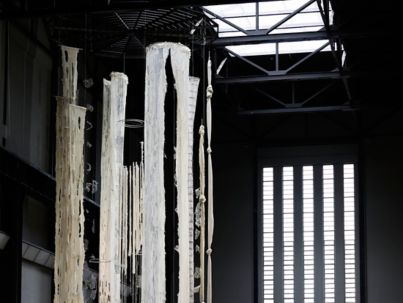- Hyundai Commission: Cecilia Vicuña: Brain Forest Quipu is open from Oct. 11, 2022 through Apr. 16, 2023 in Tate Modern’s Turbine Hall
- Renowned for her pioneering work with the Andean tradition of the quipu, Cecilia Vicuña presents her most ambitious work to date
- As part of an ongoing partnership between Hyundai Motor and Tate, the Hyundai Commission is confirmed until 2026 and represents the longest initial commitment from a corporate partner in the museum’s history
- The Hyundai Commission also represents Hyundai Motor’s commitment to supporting art, artists and audiences, and exploring possibilities for the future
Press material
-
Download
-
Images
Hyundai Motor Company and Tate Modern today announced the opening of Hyundai Commission: Cecilia Vicuña: Brain Forest Quipu as Tate Modern unveils two monumental new sculptures created by Chilean artist poet Cecilia Vicuña. Woven together from an array of different materials, they hang 27 meters from the ceiling and are positioned at opposite ends of Tate Modern’s Turbine Hall in London, England. These sculptures are combined with audio and digital installations to form Vicuña’s most ambitious work to date.
Hyundai Commission: Cecilia Vicuña: Brain Forest Quipu is the seventh annual Hyundai Commission, a series of site-specific works created for the Turbine Hall by renowned international artists as part of a unique partnership between Tate and Hyundai Motor.

Artist Cecilia Vicuña
The installation brings together different strands of Cecilia Vicuña’s practice: her use of found materials to create delicate sculptural forms, her sound work, her activism for Indigenous peoples and environmental causes, and her pioneering work with the Andean tradition of the quipu. Describing this tradition, Vicuña writes, “In the Andes people did not write, they wove meaning into textiles and knotted cords. Five thousand years ago they created the quipu, a poem in space, a way to remember, involving the body and the cosmos at once. A tactile, spatial metaphor for the union of all.”
The multi-part installation is an act of mourning for the destruction of the forests, the subsequent impact on climate change, and the violence against Indigenous people. The pale, bone-white quipu sculptures in the Turbine Hall contain a complex variety of materials, including unspun wool, plant fibres, rope, and cardboard. These are interspersed with found objects like small clay pipes and pottery fragments, which were collected from the banks of the Thames by women from local Latin American communities. The ghostly skeletal forms of these quipus stand for the dead forests and embody the delicate forces of the ecosystem, while their textures and colours evoke the bleached tree bark of forests killed by drought or intentional fire, as well as other dried-out natural substances like bone and snakeskin. Their interwoven structures also suggest deeper connections between the personal and the universal, from the mysterious grey matter of our brains to the awesome cosmology of deep time and outer space. Vicuña writes, “the Earth is a brain forest, and the quipu embraces all its interconnections.”


Left: Hyundai Commission: Cecilia Vicuña: Brain Forest Quipu Installation View at Tate Modern Right: Hyundai Commission: Cecilia Vicuña: Brain Forest Quipu Installation View at Tate Modern
A soundscape titled the ‘Sound Quipu’ is played from speakers within each sculpture. Vicuña worked with composer Ricardo Gallo on the collection of compositions, which are woven together from new improvised recordings by Vicuña, Gallo and other artists, traditional Indigenous music, field recordings of forests, and periods of contemplative silence. This ‘Sound Quipu’ is joined by a ‘Digital Quipu,’ created from the videos of Indigenous activists and land defenders, which is shown under the Turbine Hall bridge and on screens found on concourses throughout Tate Modern, as well as online.
This year's Hyundai Commission by Cecilia Vicuña encourages us to consider everything it weaves together, including ancestral knowledge, memory, and songs, as well as visitors coming together to share this collective encounter. We anticipate that it will serve as a catalyst for open and engaging conversations that pave the way for the future.

(from left to right) Frances Morris (Director of Tate Modern), Cecilia Vicuña (Hyundai Commission artist), Thomas Schemera (Global Chief Marketing Officer and Head of Customer Experience Division of Hyundai Motor Company)
Finally, a ‘Quipu of Encounters: Rituals and Assemblies’ brings together artists, activists, scientists, poets, and defenders of forests worldwide in a collective ritual that will take place at Tate on the afternoon of Friday, October 14, 2022. Through a series of events the ‘Quipu of Encounters’ invites visitors to become active in the prevention of climate catastrophe. These networks continue a process that begun at Vicuña’s exhibition Spin Spin Triangulaire at the Guggenheim Museum and will continue in other locations worldwide.
Hyundai Motor’s partnership with Tate, confirmed until 2026, is significant not only because it is the longest initial commitment from a corporate partner in Tate’s history, but due to the shared vision between Hyundai and Tate to encourage new perspectives and ideas which create dialogue between artists, audiences, and global communities. Hyundai Motor has been supporting art initiatives driven by long-term partnerships with global museums, including Tate, the National Museum of Modern and Contemporary Art, Korea (MMCA), and the Los Angeles County Museum of Art (LACMA) since 2013. In addition to the Hyundai Commission, Hyundai Motor supports the Hyundai Tate Research Centre: Transnational through its partnership with Tate. The Hyundai Tate Research Centre: Transnational launched in January 2019 and continues to help challenge and revise dominant art histories and highlight the global exchanges of artists and ideas.
Hyundai Commission: Cecilia Vicuña: Brain Forest Quipu is curated by Catherine Wood, Director of Programme and Fiontán Moran, Assistant Curator, International Art, with Helen O’Malley, Curator, Community Programmes, Tate Modern. It will be accompanied by a new book from Tate Publishing.
Hyundai Commission: Cecilia Vicuña: Brain Forest Quipu
October 11, 2022 – April 16, 2023, Tate Modern
In partnership with Hyundai Motor.
About Cecilia Vicuña
Cecilia Vicuña was born in 1948 in Santiago, Chile. She received her M.F.A. from the National School of Fine Arts, University of Chile in 1971 and went on to study at Slade School of Fine Art in London in 1972. After the military coup against former Chilean President Salvador Allende, Vicuña became a founding member of Artists for Democracy while continuing to live and work in exile in London, Colombia, USA, and Argentina through the 1970s, 80s and 90s. This sense of impermanence, and a desire to preserve and pay tribute to the country’s Indigenous history and culture, have characterized her career for over half a century. Vicuña’s art has since been acquired by and exhibited at museums around the world and she is an internationally celebrated poet. This year she had a major solo exhibition at the Solomon R. Guggenheim Museum, New York, and won a Golden Lion for lifetime achievement at the Venice Biennale. She now lives and works between Santiago and New York.
About the Quipu
The quipu (also written as khipu) is an ancient recording and communication system. It was used by the Quechua people of the Andes from 2500 BCE through to the 16th century at the time of the Spanish conquest. Quipu means ‘knot’ in the Quechua language and consisted of a long textile cord from which hung multiple strands knotted into different formations and in different colours that were able to encode as much complex information as the alphabet. Although the exact meanings behind the knot formations are not now known, it is thought that they were used to record statistics, poems and stories, thereby creating a tactile relationship to memory and the imaginary. Cecilia Vicuña has been exploring and transforming the quipu in her work for over five decades. The knots and materials are unlike the traditional form but inspired by it. Vicuña’s quipus work conceptually as poems, performance, and film, where a word, a gesture, or a group becomes a knot.
About Tate Modern’s Turbine Hall
Since Tate Modern opened in 2000, the Turbine Hall has hosted some of the world’s most memorable and acclaimed works of contemporary art, reaching an audience of millions each year. The way artists have interpreted this vast industrial space has revolutionized public perceptions of contemporary art in the twenty-first century. The annual Hyundai Commission gives artists an opportunity to create new work for this unique context. The commissions are made possible by the long-term partnership between Tate and Hyundai Motor, confirmed until 2026 as part of the longest initial commitment from a corporate partner in Tate’s history.






